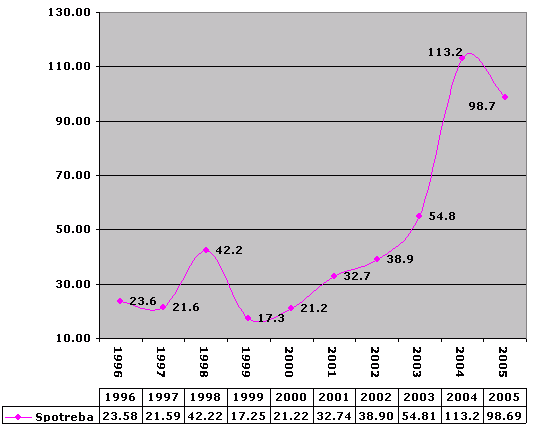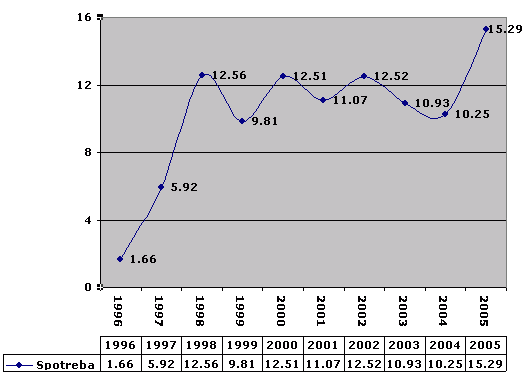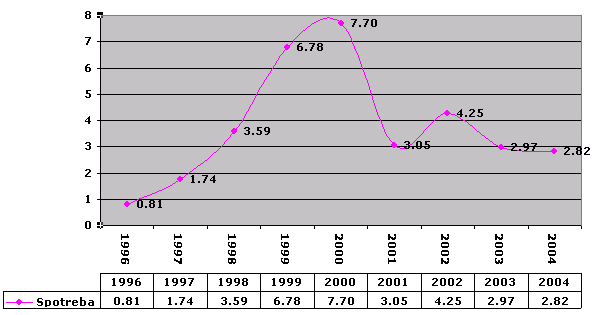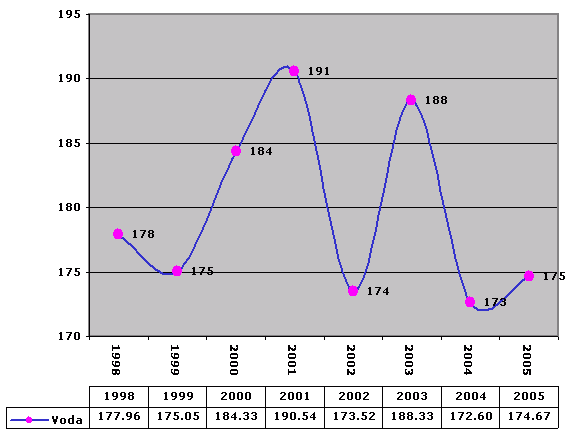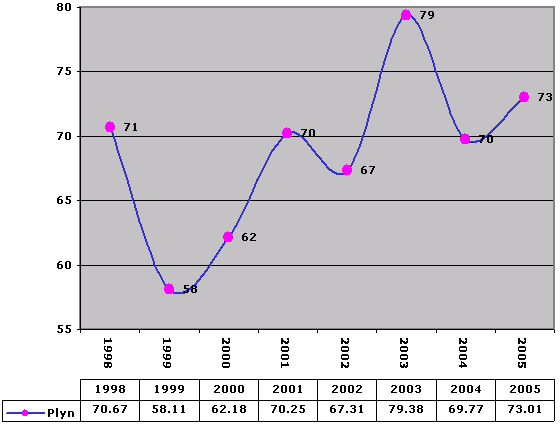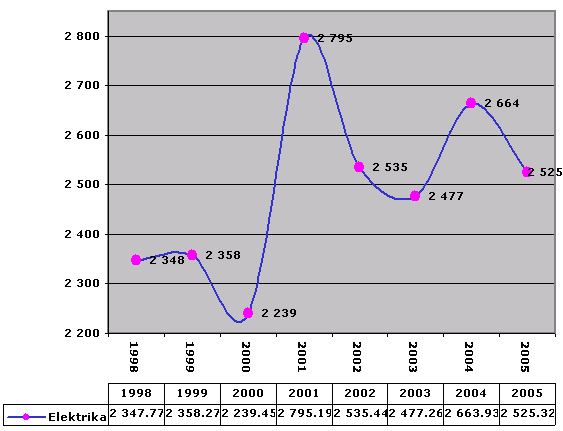Hits: 15658
Drozofily sú malé mušky, s ktorými sa podobne ako s komárom piskľavým stretol určite každý z vás. Kto by nepoznal drobné mušky, ktoré sa objavia pri ovocí, pri hrozne, kde zelenina kvasí, kysne, rozkladá sa. Drosophila melanogaster – octomilka, octová muška, ovocná muška je snáď organizmus, ktorý najviac využili a poznali biológovia, lekári celého sveta. Je ochotná sa v zajatí ľahko množiť, má rýchly reprodukčný cyklus. Génoví inžinieri sa na tejto malej muške doslova vyhrali, a výskum pokračuje ďalej. Obrazne sa dá povedať, že je to taký pokusný králik. Okrem toho je Drosophila funebris a Drosophila hydei. Novák uvádza zlatú formu s bielymi očami, tureckú – afgánsku formu, druh Drosophila buzzatii, D. muelleri. Obsahujú v sušine 51 % bielkovín, 36 % tukov, veľmi malé množstvo sacharidov, 5 % minerálnych látok. Obsah vody cca 61 % (Novák). Drozofily sú krmivom nielen pre ryby, ale aj pre vtáky a plazy. Anglicky hovoriaci svet ju pozná pod pomenovaním fruit fly, prípadne vinegar fly.
Akvaristi, napokon aj teraristi najradšej využívajú tzv. bezkrídlu formu – vestigial – antlered – strap formu. Táto vypestovaná forma krídla má, len nevie lietať, krídla má značne zakrpatené. Ak chováme násadu, dbajme na to, aby sa nám do nej nezaplietla divoká forma, pretože genetická informácia prírody vykazuje silnú dominanciu, a jediný organizmus dokáže “naučiť” lietať celú populáciu. Ak nemáme inú možnosť, môžeme chovať aj divoké drozofily. Stačí nechať na istý čas nejaké ovocie napospas osudu, ideálne je ho mechanicky narušiť, a mušky v lete takpovediac priletia samé. Potom ich stačí pochytať a uzavrieť, zabezpečiť prísun potravy. Problém však nastane, ak ich chceme skŕmiť. Keď totiž otvoríme uzáver, mušky za normálnych okolností vyletia. Riešenie existuje – stačí ich omráčiť chladom, napr. z chladničky.
Drosophila flies are small flies that everyone has likely encountered, much like the common mosquito. Who wouldn’t recognize the tiny flies that appear near fruit, grapes, where vegetables ferment, sour, decompose? Drosophila melanogaster – the vinegar fly, fruit fly, is perhaps the organism most widely used and known by biologists, doctors worldwide. It’s willing to breed easily in captivity, with a rapid reproductive cycle. Genetic engineers have literally triumphed with this small fly, and research continues. Figuratively speaking, it’s like a test rabbit. In addition, there are Drosophila funebris and Drosophila hydei. Novák mentions the golden form with white eyes, the Turkish – Afghan form, the species Drosophila buzzatii, D. muelleri. They contain 51% protein, 36% fat, very small amounts of carbohydrates, 5% minerals in dry weight. Water content is about 61% (Novák). Drosophila serve as food not only for fish but also for birds and reptiles. The English-speaking world knows it as the fruit fly or vinegar fly.
Aquarists, and finally terrarists, prefer to use the so-called wingless form – vestigial – antlered – strap form. This cultivated form of the wing cannot fly, as its wings are significantly stunted. If we are breeding a colony, we must ensure that the wild form does not get mixed in, as nature’s genetic information shows strong dominance, and only one organism can “teach” the entire population to fly. If we have no other option, we can also keep wild Drosophila. It is enough to leave some fruit exposed for some time, ideally mechanically disturbing it, and the flies will literally fly in during the summer. Then it’s enough to catch and contain them, providing a food source. However, a problem arises if we want to feed them. When we open the container, the flies will normally fly out. There is a solution – just stun them with cold, for example, from the refrigerator.
Drosophila sind kleine Fliegen, die jeder von uns sicherlich schon einmal getroffen hat, ähnlich wie die gewöhnliche Stechmücke. Wer würde die winzigen Fliegen nicht erkennen, die in der Nähe von Obst, Trauben, wo Gemüse gärt, sauer wird, verrottet? Drosophila melanogaster – die Essigfliege, die Fruchtfliege – ist vielleicht das am weitesten verbreitete und bekannteste Organismus von Biologen und Ärzten weltweit. Sie ist bereit, sich leicht in Gefangenschaft zu vermehren, mit einem schnellen Fortpflanzungszyklus. Genetiker haben mit dieser kleinen Fliege buchstäblich triumphiert, und die Forschung geht weiter. Im übertragenen Sinne ist es wie ein Versuchskaninchen. Darüber hinaus gibt es Drosophila funebris und Drosophila hydei. Novák erwähnt die goldene Form mit weißen Augen, die türkisch-afghanische Form, die Arten Drosophila buzzatii, D. muelleri. Sie enthalten 51% Protein, 36% Fett, sehr geringe Mengen Kohlenhydrate, 5% Mineralien im Trockengewicht. Der Wassergehalt beträgt ca. 61% (Novák). Drosophila dienen nicht nur als Nahrung für Fische, sondern auch für Vögel und Reptilien. Die englischsprachige Welt kennt sie als Fruchtfliege oder Essigfliege.
Aquarianer und schließlich Terrarianer verwenden am liebsten die sogenannte flügellose Form – rudimentär – geweihartig – Riemenform. Diese gezüchtete Form der Flügel kann nicht fliegen, da ihre Flügel erheblich verkümmert sind. Wenn wir eine Kolonie züchten, müssen wir sicherstellen, dass sich keine wilden Formen vermischen, da die genetischen Informationen der Natur eine starke Dominanz zeigen und nur ein Organismus der gesamten Population beibringen kann, zu fliegen. Wenn wir keine andere Möglichkeit haben, können wir auch wilde Drosophila halten. Es reicht aus, einige Zeit lang etwas Obst freizulegen, idealerweise es mechanisch zu stören, und die Fliegen fliegen im Sommer buchstäblich hinein. Dann reicht es aus, sie zu fangen und zu halten und eine Nahrungsquelle bereitzustellen. Ein Problem entsteht jedoch, wenn wir sie füttern wollen. Wenn wir den Behälter öffnen, fliegen die Fliegen normalerweise heraus. Es gibt eine Lösung – einfach mit Kälte betäuben, zum Beispiel aus dem Kühlschrank.
Návod na chov drozofíl
Do hrnca nasypeme strúhanku, cukor, ovsené vločky (najlepšie mleté), krupicu, prípadne múku alebo trochu zlatého klasu. Odporúčam viac ovsených vločiek, múčnych surovín naopak menej. Múka môže byť aj hladká, polohrubá, hrubá aj krupicová. Túto zmes na sucho poriadne premiešame. Potom pridáme vodu, asi 4 násobne v objeme viac ako sme mali tuhých zložiek a dôkladne zmes premiešame. Zmes zohrievame sa častého miešania. Nie je nutné, aby zmes zovrela, ide len o to, aby stuhla. Keď je zmes dostatočne tuhá (doslova sa neleje), hrniec môžeme odstaviť. Počas varenia si môžeme pripraviť kvasnice. Používam mrazené droždie, z ktorého odrežem kúsok a vymiešam ho v studenej, alebo vlažnej vode. Zmes pripravujem v mikrovlnke. Všetko premiešam, dám do mikrovlnky na dvadsať minút. Po skončení premiešam. Výhody sú zjavné. Nič sa nepripáli a dvadsať minút sa môžem venovať niečomu inému. Varenú zmes nechám vychladnúť, minimálne dovtedy, kým neviem na ňom udržať bez ťažkostí ruku. Urýchliť chladenie môžeme postavením hrnca do studenej vody.. Keď je už kaša dostatočne vychladnutá, vlejem do nej pripravené kvasnice z vodou a poriadne premiešam. Ideálne je nechať kvasnice 12 hodín v pokoji pôsobiť. Môžeme použiť aj ocot, ktorý som pridával spolu s kvasnicami v malom množstve. Ocot je lákadlo pre mušky a kvasnice sú účinná zbraň voči plesniam.
Túto pripravenú zmes potom nakladám to plastových pohárov, napr. do odrezaných PET fliaš. Stačí dvojcentimetrová vrstva. Potom odtrhnem kúsok toaletného papiera, zožmolím a hodím na kašu. Toaletný papier slúži na to, aby mušky mali na ňom oddychový priestor, nie je však nutný. Nesmie celkom prekryť kašu. Potom už zo zabehnutej kultúry preočkujem mušky – vysypem minimálne 30 jedincov do novej násady. Zakryjem servítkou, alebo látkou, uzavriem dvoma gumičkami. Mušky sa rýchlo rozmnožujú, jedna samička má 50 – 70 potomkov, a reprodukčný cyklus za normálnych podmienok, pri izbovej teplote, trvá 12 – 16 dní. Tak je to u D. melanogaster. D. hydei ma cyklus zhruba 24 dní. Mušky vydržia priemerne tri mesiace, potom napriek kvasniciam predsa len splesnivejú. Substrát niekedy vyschne, inokedy sa premočí. Ak je suchý, stačí doňho naliať vodu. Stáva sa niekedy, že kaša je niekedy príliš tekutá, vtedy pomôže viac toaletného papiera, ktorý vsiakne vlhkosť. To, či je kaša príliš mokrá je vidno aj podľa toho, že larvy viac vyliezajú hore. V extrémnych prípadoch sa larvy prehryzú cez servítku. Ak sú mušky hladné, tak sú menšie – často sa to stáva vtedy, ak je málo substrátu, alebo ak je vysušený. Vtedy treba buď kultúru pokropiť, alebo mušky presypať do novej, resp. správnej násady. Niektorí teraristi mušky prikrmujú, pretože sú pre ne príliš malé.
Ak vidíme známky plesne v muškách do dvoch týždňov od založenia, tak hľadajme najprv chybu. Takáto pleseň nie je v poriadku, radšej mušky vyhoďme, alebo opatrne presypme do inej kultúry. Existuje možnosť, že by sa do mušiek dostal roztoč, mne sa to však za celé roky nikdy nestalo. Ak by sa vám to stalo, mušky skŕmte a kultúru vyhoďte. Na chov použite zdravú kultúru. Chov mušiek každopádne vyžaduje skúsenosti a starostlivosť. Je zaujímavé, že každé leto, keď sa veľmi oteplí na dlhšiu dobu, to znamená nad 32 °C, tak dva týždne potom sa mi spontánne objavia jedince vo viacerých násadách, ktoré majú veľké krídla. Zhruba u štvrtiny populácie. Keď sa ochladí, mušky získajú naspäť svoju podobu. Opakuje sa mi to každý rok, obyčajne okolo 20. júla, kedy stúpajú teploty ku štyridsiatke. Predpokladám, že ide o adaptačný proces, kedy sú mušky pod veľkým biologickým tlakom vplyvom abiotického faktora.
Instructions for breeding Drosophila
In a pot, mix breadcrumbs, sugar, ground oats (preferably ground), semolina, or a bit of wheat bran. I recommend more oats and less flour. The flour can be smooth, semi-coarse, coarse, or semolina. Thoroughly mix these dry ingredients. Then add water, about 4 times the volume of the dry ingredients, and mix the mixture thoroughly. Heat the mixture while stirring frequently. It’s not necessary for the mixture to boil; it just needs to solidify. Once the mixture is sufficiently solid (literally not flowing), you can remove the pot from the heat. While cooking, you can prepare the yeast. I use frozen yeast, from which I cut off a piece and mix it in cold or lukewarm water. I prepare the mixture in the microwave. I mix everything, put it in the microwave for twenty minutes. After finishing, I stir again. The advantages are obvious. Nothing burns, and for twenty minutes, I can focus on something else. I let the cooked mixture cool, at least until I can touch it without difficulty. We can speed up the cooling process by placing the pot in cold water. When the porridge has sufficiently cooled, I pour in the prepared yeast with water and mix thoroughly. Ideally, let the yeast sit for 12 hours at rest. We can also use vinegar, which I added together with the yeast in a small amount. Vinegar is an attractant for flies, and yeast is an effective weapon against mold.
I then load this prepared mixture into plastic cups, for example, into cut PET bottles. A two-centimeter layer is enough. Then I tear off a piece of toilet paper, crumple it, and throw it on the porridge. Toilet paper serves to provide resting space for the flies but is not necessary. It must not completely cover the porridge. Then, from a established culture, I transfer the flies – I pour at least 30 individuals into a new culture. I cover it with a napkin or cloth and seal it with two rubber bands. Flies reproduce quickly; one female has 50 – 70 offspring, and the reproductive cycle, under normal conditions, at room temperature, takes 12 – 16 days. That’s the case with D. melanogaster. D. hydei has a cycle of about 24 days. Flies survive for an average of three months, then despite the yeast, they still mold. Sometimes the substrate dries out; other times it gets too wet. If it’s dry, just add water. Sometimes the porridge is too liquid, then more toilet paper helps absorb moisture. Whether the porridge is too wet can also be seen by the fact that larvae climb up more. In extreme cases, the larvae can chew through the napkin. If the flies are hungry, they are smaller – this often happens when there is too little substrate or when it is dried out. In that case, sprinkle the culture with water or transfer the flies to a new or proper culture. Some terrarists feed the flies because they are too small for them.
If we see signs of mold in the flies within two weeks of starting, let’s first look for the error. Such mold is not okay; it’s better to throw away the flies or carefully transfer them to another culture. There is a possibility that mites could get into the flies, but that has never happened to me in all these years. If it does happen to you, feed the flies and throw away the culture. Use a healthy culture for breeding. Breeding flies requires experience and care. It’s interesting that every summer, when it gets very warm for a long time, meaning above 32°C, then two weeks later, individuals with large wings spontaneously appear in several cultures, about a quarter of the population. When it cools down, the flies regain their normal appearance. This happens to me every year, usually around July 20, when temperatures rise to forty degrees. I assume it’s an adaptation process when the flies are under great biological pressure due to an abiotic factor.
Anleitung zur Zucht von Fruchtfliegen:
In einem Topf vermische ich Semmelbrösel, Zucker, gemahlenen Hafer (am besten gemahlen), Grieß oder etwas Weizenkleie. Ich empfehle mehr Hafer und weniger Mehl. Das Mehl kann glatt, halbgrob, grob oder Grieß sein. Diese trockenen Zutaten gründlich mischen. Dann füge ich Wasser hinzu, etwa das 4‑fache Volumen der trockenen Zutaten, und mische die Mischung gründlich. Erhitze die Mischung unter häufigem Rühren. Es ist nicht notwendig, dass die Mischung kocht; sie muss nur fest werden. Sobald die Mischung ausreichend fest ist (buchstäblich nicht fließt), kann ich den Topf vom Herd nehmen. Während des Kochens kann ich die Hefe vorbereiten. Ich verwende gefrorene Hefe, von der ich ein Stück abschneide und in kaltem oder lauwarmem Wasser auflöse. Ich bereite die Mischung in der Mikrowelle zu. Ich mische alles, gebe es für zwanzig Minuten in die Mikrowelle. Nach dem Ende rühre ich noch einmal um. Die Vorteile liegen auf der Hand. Nichts verbrennt, und zwanzig Minuten lang kann ich mich auf etwas anderes konzentrieren. Ich lasse die gekochte Mischung abkühlen, zumindest bis ich sie berühren kann, ohne Schwierigkeiten zu haben. Wir können den Kühlprozess beschleunigen, indem wir den Topf in kaltes Wasser stellen. Wenn der Brei ausreichend abgekühlt ist, gebe ich die vorbereitete Hefe mit Wasser hinein und mische gründlich. Ideal ist es, die Hefe 12 Stunden ruhen zu lassen. Wir können auch Essig verwenden, den ich zusammen mit der Hefe in geringer Menge zugebe. Essig ist ein Lockmittel für Fliegen, und Hefe ist eine effektive Waffe gegen Schimmel.
Dann fülle ich diese vorbereitete Mischung in Plastikbecher, zum Beispiel in abgeschnittene PET-Flaschen. Eine zwei Zentimeter dicke Schicht reicht aus. Dann reiße ich ein Stück Toilettenpapier ab, knülle es zusammen und werfe es auf den Brei. Toilettenpapier dient als Ruheplatz für die Fliegen, ist aber nicht notwendig. Es darf den Brei nicht vollständig bedecken. Dann übertrage ich aus einer etablierten Kultur die Fliegen – ich gieße mindestens 30 Individuen in eine neue Kultur. Ich decke sie mit einem Servietten oder einem Tuch ab und versiegele sie mit zwei Gummibändern. Fliegen vermehren sich schnell; ein Weibchen hat 50 – 70 Nachkommen, und der Reproduktionszyklus dauert unter normalen Bedingungen bei Raumtemperatur 12 – 16 Tage. Das ist bei D. melanogaster der Fall. D. hydei hat einen Zyklus von etwa 24 Tagen. Fliegen überleben im Durchschnitt drei Monate, dann schimmeln sie trotz der Hefe immer noch. Manchmal trocknet das Substrat aus; manchmal wird es zu nass. Wenn es trocken ist, füge einfach Wasser hinzu. Manchmal ist der Brei zu flüssig, dann hilft mehr Toilettenpapier, Feuchtigkeit aufzusaugen. Ob der Brei zu nass ist, lässt sich auch daran erkennen, dass die Larven vermehrt nach oben klettern. In extremen Fällen können die Larven das Servietten durchbeißen. Wenn die Fliegen hungrig sind, sind sie kleiner – das passiert oft, wenn zu wenig Substrat vorhanden ist oder wenn es ausgetrocknet ist. In diesem Fall besprühe die Kultur mit Wasser oder übertrage die Fliegen in eine neue oder geeignete Kultur. Manche Terrarianer füttern die Fliegen, weil sie für sie zu klein sind.
Wenn wir innerhalb von zwei Wochen nach dem Start Anzeichen von Schimmel in den Fliegen sehen, sollten wir zuerst nach dem Fehler suchen. Ein solcher Schimmel ist nicht in Ordnung; es ist besser, die Fliegen wegzuwerfen oder sie vorsichtig in eine andere Kultur zu übertragen. Es besteht die Möglichkeit, dass Milben in die Fliegen gelangen, aber mir ist das in all den Jahren noch nie passiert. Wenn es dir passiert, füttere die Fliegen und wirf die Kultur weg. Verwende eine gesunde Kultur zur Zucht. Die Zucht von Fliegen erfordert Erfahrung und Sorgfalt. Interessanterweise treten jedes Jahr im Sommer, wenn es für längere Zeit sehr warm wird, also über 32 °C, zwei Wochen später spontan Individuen mit großen Flügeln in mehreren Kulturen auf, etwa ein Viertel der Population. Wenn es abkühlt, bekommen die Fliegen ihr normales Aussehen zurück. Das passiert mir jedes Jahr, normalerweise um den 20. Juli herum, wenn die Temperaturen auf vierzig Grad steigen. Ich nehme an, es handelt sich um einen Anpassungsprozess, wenn die Fliegen unter großem biologischem Druck aufgrund eines abiotischen Faktors stehen.
Kŕmenie muškami
Skrmovanie mušiek je pomerne jednoduché. Stačí mať prístup na hladinu. Násadu odgumičkujeme, servítok zahodíme, otočíme ju a buchnutím dlane vysypeme na hladinu. Aby sme zabránili prípadnému padnutiu servítka s kašou do nádrže, robíme to opatrne, a pomôcť si môžeme vsunutím jedného prstu cez otvor. Pri skrmovaní mušiek si treba všímať, či ryby mušky chytajú. Ak je to pre ryby nový druh potravy, nejaký čas môže trvať, kým ju budú akceptovať. Je samozrejme, že ak by sme chovali napr. pancierniky, tak mušky nie sú pre ne správna voľba. Ale napr. tetry vám za mušky aj “ruky vybozkávajú” :-). Isteže aj stres môže spôsobiť, že si ryby potravu adekvátne nevšímajú.
V prípade, že mušky dostanú čas, “nájdu” si kraj nádrže a snažia sa dostať von z vody. Je zaujímavé, že väčšina z nich, po vyslobodení z vody, neustále “pochoduje” po hranách bočných skiel. Pravdepodobne im voňajú ich “kamarátky” a preto ich snaha ujsť preč nie je veľká. V prípade, že mušky ktoré sme vysypali rybám, chceme ešte použiť, opäť ich zakryjeme čistým servítkom. Rozhodnutie je na nás, podľa toho, či sa má ešte čo vyliahnuť.
Feeding the Flies
Feeding flies is relatively straightforward. You just need access to the surface. Unfasten the culture, discard the tissue, flip it over, and tap it gently with your palm to empty it onto the surface. To prevent the tissue with the paste from falling into the tank, do this carefully, and you can use one finger to help through the hole. When feeding flies, pay attention to whether the fish are catching them. If it’s a new type of food for the fish, it may take some time for them to accept it. Of course, if you were keeping, for example, armored catfish, flies wouldn’t be the right choice for them. But, for example, tetras will be very excited about flies :-). Certainly, stress can also cause fish not to pay adequate attention to food.
If the flies have time, they will “find” their way to the edges of the tank and try to get out of the water. It’s interesting that most of them, after being freed from the water, continuously “march” along the edges of the side glass. Presumably, they can smell their “friends,” so their attempt to escape is not great. If we want to reuse the flies we’ve poured for the fish, cover them again with a clean tissue. The decision is up to us, depending on whether there is still something left to hatch.
Fütterung der Fliegen
Das Füttern von Fliegen ist relativ unkompliziert. Sie benötigen nur Zugang zur Oberfläche. Lösen Sie die Kultur, werfen Sie das Gewebe weg, drehen Sie es um und klopfen Sie es vorsichtig mit Ihrer Handfläche aus, um es auf die Oberfläche zu leeren. Um zu verhindern, dass das Gewebe mit dem Brei ins Becken fällt, sollten Sie dies vorsichtig tun, und Sie können einen Finger benutzen, um durch das Loch zu helfen. Achten Sie beim Füttern von Fliegen darauf, ob die Fische sie fangen. Wenn es sich um eine neue Art von Futter für die Fische handelt, kann es einige Zeit dauern, bis sie es akzeptieren. Natürlich wären Fliegen für Fische wie gepanzerte Welse keine gute Wahl. Aber zum Beispiel werden Tetras sehr begeistert von Fliegen sein :-). Sicherlich kann auch Stress dazu führen, dass Fische der Nahrung nicht angemessen Aufmerksamkeit schenken.
Wenn die Fliegen Zeit haben, werden sie “ihren” Weg zu den Rändern des Beckens finden und versuchen, aus dem Wasser zu gelangen. Es ist interessant, dass die meisten von ihnen, nachdem sie aus dem Wasser befreit wurden, kontinuierlich entlang der Ränder des Seitenglases “marschieren”. Wahrscheinlich können sie ihre “Freunde” riechen, sodass ihr Fluchtversuch nicht groß ist. Wenn wir die Fliegen, die wir für die Fische ausgegossen haben, wieder verwenden möchten, bedecken wir sie erneut mit einem sauberen Taschentuch. Die Entscheidung liegt bei uns, je nachdem, ob noch etwas zu schlüpfen übrig ist.
Odkazy


Use Facebook to Comment on this Post



